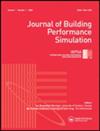Validation of spectral simulation tools in the context of ipRGC-influenced light responses of building occupants
IF 2.3
4区 工程技术
Q2 CONSTRUCTION & BUILDING TECHNOLOGY
引用次数: 6
Abstract
With the growing awareness about ipRGC-influenced light (IIL) responses, design applications related to these responses are flourishing. To compare design options and optimize lighting conditions for building occupants, lighting simulations are typically used. However, as our IIL responses depend on the spectral characteristics of light, spectral simulations are required. The goal of this study is to validate two spectral simulation tools, ALFA and Lark, for the study of indoor spaces in relation to occupants’ IIL responses. Indicators associated with IIL responses derived from ALFA- and Lark-simulated data are compared against indicators derived from data measured under indoor daylighting and electric lighting conditions. The results show that Lark outperforms ALFA in most cases, with a simulation error in the ±20% range for point-in-time indicators. When accounting for time dynamics of light exposure, at least 9% of the daylight exposures simulated for a 6-h period in Lark lead to a significant error.光谱模拟工具在iprgc影响建筑居住者光响应的背景下的验证
随着人们对iprgc影响的光(IIL)响应的认识不断提高,与这些响应相关的设计应用正在蓬勃发展。为了比较设计方案和优化建筑居住者的照明条件,通常使用照明模拟。然而,由于我们的IIL响应依赖于光的光谱特性,光谱模拟是必需的。本研究的目的是验证两种光谱模拟工具,ALFA和Lark,用于研究室内空间与居住者il反应的关系。从ALFA和lark模拟数据中得出的与IIL响应相关的指标与在室内采光和电力照明条件下测量的数据得出的指标进行了比较。结果表明,Lark在大多数情况下优于ALFA,对于时间点指标的模拟误差在±20%范围内。当考虑光照射的时间动态时,在Lark中模拟的6小时内至少有9%的日光照射会导致显着误差。
本文章由计算机程序翻译,如有差异,请以英文原文为准。
求助全文
约1分钟内获得全文
求助全文
来源期刊

Journal of Building Performance Simulation
CONSTRUCTION & BUILDING TECHNOLOGY-
CiteScore
5.50
自引率
12.00%
发文量
55
审稿时长
12 months
期刊介绍:
The Journal of Building Performance Simulation (JBPS) aims to make a substantial and lasting contribution to the international building community by supporting our authors and the high-quality, original research they submit. The journal also offers a forum for original review papers and researched case studies
We welcome building performance simulation contributions that explore the following topics related to buildings and communities:
-Theoretical aspects related to modelling and simulating the physical processes (thermal, air flow, moisture, lighting, acoustics).
-Theoretical aspects related to modelling and simulating conventional and innovative energy conversion, storage, distribution, and control systems.
-Theoretical aspects related to occupants, weather data, and other boundary conditions.
-Methods and algorithms for optimizing the performance of buildings and communities and the systems which service them, including interaction with the electrical grid.
-Uncertainty, sensitivity analysis, and calibration.
-Methods and algorithms for validating models and for verifying solution methods and tools.
-Development and validation of controls-oriented models that are appropriate for model predictive control and/or automated fault detection and diagnostics.
-Techniques for educating and training tool users.
-Software development techniques and interoperability issues with direct applicability to building performance simulation.
-Case studies involving the application of building performance simulation for any stage of the design, construction, commissioning, operation, or management of buildings and the systems which service them are welcomed if they include validation or aspects that make a novel contribution to the knowledge base.
 求助内容:
求助内容: 应助结果提醒方式:
应助结果提醒方式:


